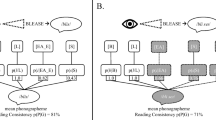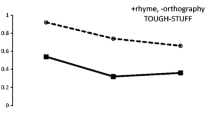Abstract
Two studies examined whether young children use their knowledge of the spelling of base words to spell inflected and derived forms. In Study 1, 5- to 9-year-olds wrote the correct letter (s or z) more often to represent the medial /z/ sound of words derived from base forms (e.g., noisy, from noise) than to represent the medial /z/ sound of one-morpheme control words (e.g., busy). In Study 2, 7- to 9-year-olds preserved the spelling of /z/ in pseudoword base forms when writing ostensibly related inflected and derived forms (e.g., kaise-kaisy). In both studies, the children’s tendency to preserve the spelling of /z/ between base and inflected/derived words was related to their performance on analogy tasks of morphological awareness. These findings add to the growing body of evidence that children recognise and represent links of meaning between words from relatively early in their writing experience, and that morphological awareness facilitates the spelling of morphologically complex words.
Similar content being viewed by others
References
Arnbak E., Elbro C., (2000). The effects of morphological awareness training on the reading and spelling skills of young dyslexics Scandinavian Journal of Educational Research 44: 229–251
Berko J., (1958). The child’s learning of English morphology Word 14: 150–177
Bryant P. E., Nunes T., Bindman M., (1998). Awareness of language in children who have reading difficulties: A longitudinal, historical studyJournal of Child Psychology and Psychiatry and Allied Disciplines 39: 501–510
Carlisle J. F., (1988). Knowledge of derivational morphology and spelling ability in fourth, sixth and eighth graders Applied Psycholinguistics 9: 247–266
Carlisle J. F., (1995). Morphological awareness and early reading achievement In: Feldman L. B., (eds), Morphological aspects of language processing. Lawrence Erlbaum, Hillsdale, NJ , pp. 189–209
Carroll J., Davies P., Richman B., (1971). The American heritage word frequency book Houghton Mifflin, Boston
Derwing B. L., Smith M. L., Wiebe G. E., (1995). On the role of spelling in morpheme recognition: Experimental studies with children and adults In: Feldman L. B., (eds), Morphological aspects of language processing. Lawrence Erlbaum, Hillsdale, NJ, pp. 3–27
Ehri, L. C. (1986). Sources of difficulty in learning to read and spell. In: M. L. Wolraich & D. Routh (Eds.), Advances in developmental and behavioural pediatrics (Vol. 7, pp. 121–195). Greenwich, CT: JAI
Fowler A. E., Liberman I. Y., (1995). The role of phonology and orthography in morphological awareness In: Feldman L. B. (eds), Morphological aspects of language processing. Lawrence Erlbaum, Hillsdale NJ, pp. 157–188
Gentry J. R., (1982). An analysis of developmental spelling in GYNS AT WRK The Reading Teacher 36: 192–200
Green L., McCutchen D., Schwiebert C., Quinlan T., Eva-Wood A., Juelis J., (2003). Morphological development in children’s writing Journal of Educational Psychology 95: 752–761
Hauerwas L. B., Walker J., (2003). Spelling of inflected verb morphology in children with spelling deficits Learning Disabilities Research and Practice 18: 25–35
Henderson E. H., Templeton S., (1986). A developmental perspective of formal spelling instruction through alphabet, pattern, and meaning The Elementary School Journal 86: 305–316
Henry M. K., (1988). Beyond phonics: Integrated decoding and spelling instruction based on word origin and structure Annals of Dyslexia 38:259–275
Kemp N., Bryant P., (2003). Do beez buzz? Rule-based and frequency-based knowledge in learning to spell plural -s Child Development 74: 63–74
Leong C. K., (2000). Rapid processing of base and derived forms of words and grade 4, 5, and 6 children’s spelling Reading and Writing 12: 277–302
Levin I., Ravid D., Rapaport S., (1999). Developing morphological awareness and learning to write: A two-way street In: Nunes T. (eds), Learning to read: An integrated view from research and practice. Kluwer, Dordrecht, The Netherlands, pp. 77–104
Lovett M. W., (1999). Defining and remediating the core deficits of developmental dyslexia: Lessons from remedial outcome research with reading disabled children. In: Klein R. M., McMullen P. (eds), Converging methods for understanding reading and dyslexia. MIT Press, Cambridge, MA, pp. 111–132
Marsh G., Friedman M. P., Welch V., Desberg P. (1980). The development of strategies in spelling In: Frith U. (eds), Cognitive processes in spelling. Academic Press, London, pp. 339–353
Nagy W. E., Anderson R. C., (1984). The number of words in printed school English Reading Research Quarterly 19: 304–330
Nunes T., Bryant P. E., Bindman M., (1997a). Morphological spelling strategies: Developmental stages and processes Developmental Psychology 33: 637–649
Nunes T., Bryant P. E., Bindman M., (1997b). Learning to spell regular and irregular verbs Reading and Writing 9: 427–449
Nunes T., Bryant P. E., Olsson J., (2003). Learning morphological and phonological spelling rules: An intervention study Scientific Studies of Reading 7: 289–307
Pacton S., Perruchet P., Fayol M., Cleeremans A., (2001). Implicit learning out of the lab: The case of orthographic regularities Journal of Experimental Psychology: General 130: 401–426
Rubin H., (1988). Morphological knowledge and early writing ability Language and Speech 31: 337–355
Rust J., Golombok S., Trickey G., (1993). Wechsler objective reading dimensions Harcourt Brace, London
Share D. L., (1995). Phonological recoding and self-teaching: Sine qua non of reading acquisition. Cognition 55: 151–218
Share D. L., (1999). Phonological recoding and orthographic learning: A direct test of the self-teaching hypothesis Journal of Experimental Child Psychology 72: 95–129
Treiman R., Cassar M., (1996). Effects of morphology on children’s spelling of final consonant clusters Journal of Experimental Child Psychology, 63: 141–170
Treiman R., Cassar M., Zukowski A., (1994). What types of linguistic information do children use in spelling? The case of flaps Child Development 65: 1318–1337
Wysocki K., Jenkins J. R., (1987). Deriving word meanings through morphological generalization Reading Research Quarterly 22: 66–81
Zutell J., (1980). Children’s spelling strategies and their cognitive development. In: Henderson E., Beers J. (eds), Developmental and cognitive aspects of learning to spell: A reflection of word knowledge. International Reading Association, Newark DE, pp. 52–73
Acknowledgements
This research was conducted while the author was a doctoral student in the Department of Experimental Psychology at the University of Oxford, and was funded by a Commonwealth Scholarship.
Author information
Authors and Affiliations
Corresponding author
Appendix A
Appendix A
Study 1: Experimental Words
Base words, with s: noise, rose, nose, lose, wise, chose; with z: breeze, freeze, sneeze, buzz, froze, fizz. Derived words, with s: noisy, rosy, nosy, loser, wisest, chosen; with z: breezy, freezer, Sneezy, buzzer, frozen, fizzy. Control words, with s: daisy, easy, busy, poison, pleasant, raisin; with z: crazy, bulldozer, wizard, razor, dozen, dizzy.
NB. Four ‘Control’ words are related to other words: crazy to craze, razor to raze, easy to ease, and pleasant to please. However, craze, raze, and ease are much rarer than their derived forms, and seemed unlikely to␣be known by most of the children tested. Please is relatively frequent, but its connection to pleasant was thought not to be obvious to young children.
Study 1: Sentence Analogy Task of Morphological Awareness
Practice analogies |
a. The sun is shining. It’s a sunny day. |
There’s fog all around. It’s a ______ (day). |
b. Betty is good at cooking. She’s a good cook. |
Sue is good at reading. She's a good ______. |
c. Ben likes building things. He wants to be a builder. |
Laura likes nursing sick people. She wants to be a _________. |
Test analogies |
1. That man comes from France. He is French. |
That man comes from England. He is ________. |
2. That lady is good at dancing. She's an excellent dancer. |
That lady is very good at acting. She’s a famous __________. |
3. Everyone talks about how good Bill is at music. They say he is very musical. |
Everyone talks about Angela’s beauty. They say she is very __________. |
4. He’s going to count along two. It’s the second one. |
He’s going to count along four. It’s the __________ (one). |
5. I sometimes feel full of anger. Then I am angry! |
I sometimes feel full of fury. Then I am ________! |
6. John likes to cycle in the park. He’s a keen cyclist. |
Jack likes to run in the park. He’s a keen _______. |
7. Tim is better at maths than anyone else in the class. He’s the best at maths. |
Jill is faster at running than anyone else in the class. She’s the _______ (at running). |
8. Mum told me about all the colours in the painting. She said it’s very colourful. |
Mum told me about the dangers if you climb that wall. She said it’s very _______. |
Study 2: Experimental Words
Clue words (in parentheses) and pseudowords presented in each sentence context type. The spellings given for the pseudowords are just one possible way of representing their sounds.
‘Base provided’ sentences, inflected words, with -s: (mease) meases, (pluse) pluses, (ploze) plozes, (coize) coizes, with -ed: (jaise) jaised, (drease) dreased, (oze) ozed, (wuze) wuzed. Derived words, with -y: (kaise) kaisy, (glise) glisy, (boze) bozy, (fruze) fruzy; with -er: (taise) taiser, (hise) hiser, (moize) moizer, (woze) wozer. ‘Copy word’ sentences, inflected words, with -s: (zoses) zoses, (oises) oises, (fizes) fizes, (reazes) reazes, with -ed: (chised) chised, (steesed) steesed, (bazed) bazed, (neazed) neazed. Derived words, with -y: (thaisy) thaisy, (toosy) toosy, (tazy) tazy, (moozy) moozy; with -er: (beaser) beaser, (cluser) cluser, (pazer) pazer, (bleezer) bleezer. ‘Pseudoclue’ sentences, inflected words, with -s: (noses) jises, (roses) doises, (dozes) bizes, (sizes) foozes, with -ed: (pleased) mosed, (closed) preased, (amazed) truzed, (sneezed) fozed. Derived words, with -y: (busy) naisy, (easy) nisy, (breezy) foizy, (lazy) wuzy; with -er: (loser) keaser, (laser) voser, (buzzer) aizer, (bulldozer) drazer.
Study 2: Tasks of Morphological Awareness
First practice item of each task shows full analogy format. Subsequent items show sentence frame, followed by Puppet 1 target word, Puppet 2 response, Puppet 1 target, Child response.
a. |
|---|
Plurals |
Practice analogies |
a. I want to see the big mountain. I want to see the big mountains. |
I want to see the big hill. _________________________. |
b. Look at the ________ over there. (children - child, trees - ?) |
Test analogies. |
1. I found the pretty ________ in the woods. (leaf - leaves, box - ?) |
2. I like the ________ from next door. (cat - cats, mouse - ?) |
3. The __________ cooked a cake. (women - woman, boys - ?) |
4. I hurt my ________ on the way here. (feet - foot, teeth - ?) |
b. |
|---|
Verbs |
Practice analogies |
a. I talk to my friends. I talked to my friends. |
I play with my friends. __________________. |
b. I ______ a bird in the tree. (heard - hear, saw - ?) |
Test analogies |
1. He _______ a long way. (walks - walked, runs - ?) |
2. Jane ________ the ball over the wall. (threw - throws, kicked - ?) |
3. The dog __________ the chair. (scratched – is scratching, chased - ?) |
4. Bob _________ the ball to Anne. (gives - gave, sings - ?) |
c. | ||
|---|---|---|
Nouns | ||
Practice analogies: | Test analogies: | |
a. teacher teach | b. reading reader | 1. act actress |
singer _______ | cooking _______ | dance _______ |
2. runner run | 3. ballerina ballet | 4. serve servant |
cyclist _______ | musician _______* | build ________ |
d. | ||
|---|---|---|
Adjectives | ||
Practice analogies: | Test analogies: | |
a. wonder wonderful | b. luck lucky | 1. wooden wood |
fame _______ | hope _______ | dirty _______ |
2. happiness happy | 3. warm warmth | 4. danger dangerous |
strength _______ | high _______ | colour ________ |
Rights and permissions
About this article
Cite this article
Kemp, N. Children’s spelling of base, inflected, and derived words: Links with morphological awareness. Read Writ 19, 737–765 (2006). https://doi.org/10.1007/s11145-006-9001-6
Received:
Accepted:
Published:
Issue Date:
DOI: https://doi.org/10.1007/s11145-006-9001-6




